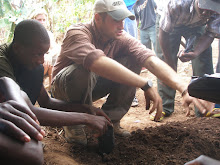 |
Kirembe with the Renzori mountains behind
Yesterday we finished up our second training in in
Kirembe. The group wasn’t as organized
as the beekeepers in Bwera, but there are always a few good examples in every
group, and this one was no different.
|
The first day we ended up waiting for the farmers
for about 3 hours. The first person to
arrive was a woman dressed in a nice Ugandan dress like she was going to
church. Simon told me that she had
walked about three hours to come. He said “she lives behind these mountains
somewhere thereeeee,” as he raised the pitch of his voice to indicate the distance
he reached up and over an imaginary mountain to point to a far off place. I looked at her and said, “oh wow,” to show
her I was impressed. But she just looked
forward and pursed her lips and nodded to show that it was no big
deal. I used the little Lukongho that
Simon and Jockus had taught me and said “Wasinja Kutsibu,” which means thank you very much as I dug out
the protein bar that I packed for lunch and gave it to her. She was definitely confused by it, but ate it
one little piece at a time, I could tell because every time she took another
piece I could hear the wrapper rattling.
When two more people showed up, I heard the wrapper rattle again as she
shared pieces with them.
 |
| THe talking begins again |
Eventually when we had five people or so I said to
Simon we better start or we will be here until dark. I could tell some of the people had come
straight from their fields; it wasn’t long before people started nodding off in
the hot and dark church. I used the same
program that we used in Bwera, but I tried to make it more interactive to keep
people from nodding off too much.
As soon as we got to talking about different types
of hives, I asked everybody that was already keeping bees to tell us about the
types of hives they kept. This turned
into a lively discussion, and an old man that has close to 100 hives took over
the class describing the different types of local hives he has built, and
described how he builds top bar hives.
This gave Simon and I a nice break, as he just whispered to me the
occasional translation. I could mostly
tell what the man was describing by his animated hand motions. It was a good discussion of how to use cheap local materials to make hives.
By the time I started talking about the advantages
of different types of hives there were closer to 12 participants. I was glad more people were there for that
discussion; it’s good for new beekeepers to hear that local hives are just as
valuable as the “modern” hives, they just have different purposes. One is good
for intensive beekeeping, while the other is good for extensive
beekeeping. Every group should have a
mix of the two.
 |
| KTB hives in the old man's apiary |
Finally I wrapped up the first day talking about
colony management. I spent more time
this go around talking about how to approach a hive, and how to work it calmly,
efficiently, and safely. Last time I
left that topic for after our practical visit to an apiary, which made for a
bit of chaos at the beginning. This time I made sure people knew what my
expectations were for working in the apiary ahead of time. I also made sure to say that people should be
there at 9 am so we could get to the apiary before it gets too hot! I was really happy to see the chairperson for this group was a woman. She thanked me for the day, and urged me to come again and again.
The next morning of course folks weren’t there at
9, but the church we were teaching in was full because it was Ash Wednesday. Simon passed the time chatting with some of the old men waiting outside of the church. The first farmer that came carried a Kenyan top bar (KTB) hive that he built, to get our advice. This drew the attention of the old men, and soon we had a crowd of people standing around the hive asking questions. I could see Simon's excitement as he answered all of their questions with my occasional help....He's a true extension man!
 |
| showing the group capped brood. |
When everybody showed up we headed over to the apiary of the old man who had described the local hives the day before. It was really impressive!!! the apiary was in the middle of a huge Moringa Olefera grove (A fantastic agroforestry tree that has tremendous medicinal qualities, and is good bee forage). The apiary itself had a tall dense living fence around it. Inside there was close to 100 hives, a long line of KTB, then again long lines of the local hives he had described side by side, with about a meter in between them.
This time we went to the KTB hive first. It was a strong colony and people once again had the chance to see eggs, capped brood, larva, nectar, capped honey, and pollen. Still having a hard time finding queens here in Africa, but I'm still holding out hope. I always tell people if you see the eggs you know a queen was there at least three days ago. We straightened out a few small gaps, and closed up the KTB.
 |
| Locally made, fixed comb hive |
|
|
drawn out comb in a fixed comb hive hive
|











2 comments:
Wow, funny narrative, this is awesome Dan!
Post a Comment